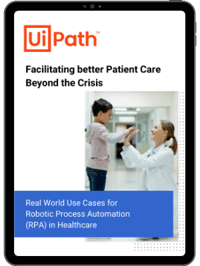Helse Vest | Reducing administrative burden with Robotic Processing Automation (RPA)
The Norwegian Helse Vest health authority has been working on an RPA rollout for some time. In doing so, it’s been considering how to best cut out time-intensive and repetitive tasks across the organisation, not just in silos.
It owns and manages five health trusts in the western regions of Norway, Rogaland and Vestland. As a result, it cares for about a million residents as one of four regional health authorities in the country, answering directly to the Ministry of Health and Care Services.
The authority uses RPA to reduce the administrative burden on its doctors and nurses allowing them to spend more time with patients. Line Fjeldstad, a midwife at Helse Vest, explains that robots have taken the “purely depreciative jobs” from nurses. Jobs that eat time but add little value.
One of the first processes automated related to prostate cancer patients. The same information about the patient is required in three different systems meaning doctors not just had to undertake data entry, but in triplicate.
A robot, which the team affectionately named Robbie Vest, took over and automatically updates all the relevant systems. What had taken doctors 10 minutes to complete manually now takes two, while also improving the quality of the reports. Alfred Honoré, Chief physician at Haukeland University Hospital, told the Norwegian medical journal, Dagens Medicin, “My workload is significantly reduced, while the quality of the data is better.”
However, the work didn’t stop there. A wide range of activities has been automated, including the collection of information on pregnant women as they prepare to give birth. Previously, the patient had to print off a long-form, fill it in and physically return it to the hospital. This information then had to be entered into multiple systems. This was digitised and then Robbie was used to extract information and update systems, improving the experience for nurses and patients.
Gry Oberstad, a midwife at Helse Vest says, “Robbie saves us and the pregnant women both time and resources. Previously, it took the equivalent of 1.5 staff members to handle the process and now it’s all automated. The fact that the robot does the job ensures correct information and higher quality.”
Today, Helse Vest has automated more than 50 processes and the team estimates that Robbie gives the authority’s doctors and nurses more than 14,000 hours back each year. And while we can point to single-use cases within the organisation as examples of RPA in action, the way it’s used spreads throughout the entire organisation, illustrating a more strategic approach.1
Want to learn more about Robotic Process Automation (RPA) and real-world use cases post-pandemic?
Download our free whitepaper where we consider the role of Robotic Process Automation (RPA) in healthcare to date by reviewing real-life use cases of RPA in the UK, US, Canada, India, and Norway, as well as exploring how healthcare leaders can use RPA in the coming years to catch-up and then accelerate.
1. UiPath, Robbie Vest becomes a ‘valued colleague’ for clinical staff at Helse Vest
.png)
Want to learn more about Robotic Process Automation (RPA) and real-world use cases post-pandemic?

Download our free whitepaper where we:
- Consider the role of RPA in healthcare to date
- Review real-life use cases of RPA in the UK, US, Canada, India, and Norway
- Explore how healthcare leaders can use RPA in the coming years to catch-up and then accelerate.
%20(1).png?width=500&height=58&name=HETT%20insights%20logo%20RGB-04%20(1)%20(1).png)

